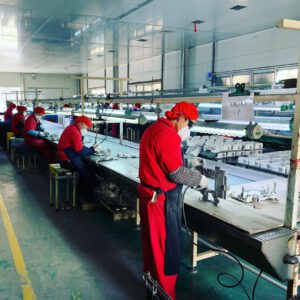The Great Benefits of Adopting a Global Concurrent Engineering (GCE) Model
Conceptualized in the 1900’s and grown during WWII, concurrent engineering (CE) has been the most competitive operation model used by some leading industries. Since the 1980’s, the semiconductor industry has been using CE to achieve superb speed to market for both IC chips and equipment manufacturing. However, due to restrictions in both resources and operational capabilities, only a few of business in other industries are able to practice this model. From design to manufacturing has always been a major challenge – implementing this at a global scale only exacerbates the situation. With 20 years of development experience and successes, E-BI can help clients to ramp up their Global Concurrent Engineering (GCE) workflow seamlessly using its artificial intelligence based global supply chain management system (GSCM), cross-functional specialty engineering teams and Star Factory Alliance. The GCE model will not only shorten your time on proving a new product’s manufacturability during the NPI stage, but also achieve the fastest speed to market.
A successful new product launch has to overcome many barriers such as design creativity, cost, quality, lead-time to market, and more. Most businesses go through development stages in a traditional sequential manner. The overall development could have years of progress, only to find out it has to go back to the drawing boards due to a slight misjudgment. How can you effectively solve these problems and save millions of dollars to both minimize and optimize this lengthy process? The solution requires an operational matrix. E-BI’s GCE model greatly reduces the overall time and cost up to 80%.

How does this work? The workflow is actually pretty simple. All a client needs to do is to have E-BI’s NPI team working in parallel with your R&D and engineering team at the design state. E-BI will provide sourcing quotes and manufacturing process suggestions in real-time. Behind the scenes, E-BI will secure manufacturability, cost model, and sub-contractor network development, among other things, all at the same time to optimize cost and development time. It is just that simple!
Here is a detailed list of benefits:
- Product Cost
Creative designers innovate on new form, functions and features of a product. However, the cost of product manufacturing often complicates a later business decision. Ideally, it would be best to know if the market can really accept the cost associated with the design before a designer commits his time to the project. Moving the Design For Cost (DFC) analysis earlier and finding the cost real time during the design stage is critical to confirm a design path. Only a team competent in global sourcing can effectively accomplish DFC during the design stage with a low overhead. - Manufacturability

No matter how great a product may look and function on paper, a product is only as good as its manufacturability – if it can’t be built, it’s an idea not a product. Of course, if one factory cannot make it, it does not mean it’s not manufacturable; by using different equipment or applying different manufacturing techniques, we are able to provide a myriad of solutions. This requires specialty sourcing from a large manageable resource pool. E-BI Star Factory Alliance offers a broad range of capabilities for designers and engineers to choose from. By having a larger manufacturing base and specialists in specific manufacturing processes, we can give designers more freedom and flexibility in their product. - BOM Lead Time
A product BOM can range anywhere from a few parts to hundreds of parts. As the production lead time is determined by the part with the longest lead time, poor BOM selection can completely jeopardize the supply chain response speed and even complicate the commercial aspects of manufacturing. This is especially true for clients using a Just-in-time (JIT) model. As an example, if a certain CPU chip or a special plastic resin has an 18 week lead time to be delivered from a global manufacturing site, each production batch will take at least 18 weeks plus manufacturing time; this requires accurate forecasting and planning to ensure deliveries. If an alternative chip that is widely available locally is instead selected, BOM lead time can be cut down from 18+ weeks to only manufacturing lead time. A change in component or material selection offers dramatic business advantages and increased flexibility. - Material Availability
Material availability differs significantly from country to country because of a tier 3 supplier’s distribution strategy. Technical support of the material may also not be available in a certain region. Selecting the best materials requires knowledge in material specifications, material availability, and manufacturer support. Often times very similar materials are readily available and can offer cost savings and decreased lead times. - Prototype Making
Prototypes are used to validate a design concept. Making a prototype with manufacturability in mind is critical to ensure manufacturability and control production costs. At the design stage, with the GCE model, making a prototype from a qualified sub-contractor can help to get samples in hand to better grasp product concept and features. - Sourcing
With GCE, we can begin sourcing at the very early stages of product development with our worldwide resources. A product needs to establish its own unique manufacturing network that is specific to its own supply chain dynamics. In such a system, all partners must have matching capability and motivations in technologies, qualifications, price, volume, capacity, MOQ, speed of response, logistics, trade, tax, payment term, etc. Developing such a supply chain system takes time and effort and involves challenging management tasks. With E-BI Star Factory Alliance and its history with manufacturers, E-BI is able to quickly develop and implement complex supply chains to offer superior time to market and cost savings. All of these resource allocations and alignment around the world eventually defines the competitiveness of this product. - Manufacturing System Set-Up
From tier 1 to tier 3, a sub-contractor network needs to be integrated together to perform the JIT production model. Within the manufacturing ecosystem, each sub-con must commit and operate at the same pace on labor, training, quality system, process, equipment, test, material and compliance. A quality product build relies on the strength of everyone in the sub-contractor network. GCE model helps to save valuable time by quickly establishing a manufacturing supply chain using our comprehensive network of approved factories that we have used throughout our 20 year history.
E-BI team members working on a project setup - Early Supply Chain Design and Planning
Extended supply chain design refers to logistics availability, cost, international tariffs, government red-tape, and business law. Since every country and region has its special policies, a resilient supply chain should be able to weather changes that happen from time to time. Our network offers redundancies of suppliers as well as flexibility in each of these areas to ensure that your product can be delivered regardless of the political or weather climate. - E-BI Recommendations on New Material, Process, and Technologies to Make Better Products
There is always a better way to make a product. New technologies improve the manufacturing world everyday. New material and processes from different industries can be brought in to enhance the design, performance and cut costs. E-BI’s GCE model with broad cross functional specialty groups can help to recommend new solutions to designers at an early stage by implementing manufacturing techniques previously foreign to existing industries. - New Thoughts on Both DFM and DFC
Both DFM and DFC are usually the first two steps at NPI. Both tooling and mold design are closely related to the DFM process. E-BI specialty engineers can provide instant feedback on tooling options to help expedite the manufacturing process. This will also allow for accurate unit price estimations to be calculated during the tooling process. At this time, additional DFC recommendations are presented to provide a cost competitive product. With the GCE model, E-BI’s engineering team research can help bring cross discipline industry knowledge to both DFM and DFC tasks.
Implementing the GCE model could save a company up to 80% of cost and time needed for rolling out a new product. E-BI has been working with clients on many new NPI projects in numerous industries such as consumer electronics, homeware and houseware, industrial equipment, medical, and sportswear products. We make it possible with our unique AI based GSCM (Global Supply Chain Management) system, top notch cross functional engineering specialty teams, and Star Factory Alliance in global locations such as China, Vietnam, Thailand, Taiwan, Myanmar, and India. Together we can advance your business operation and time to market in this competitive landscape.

